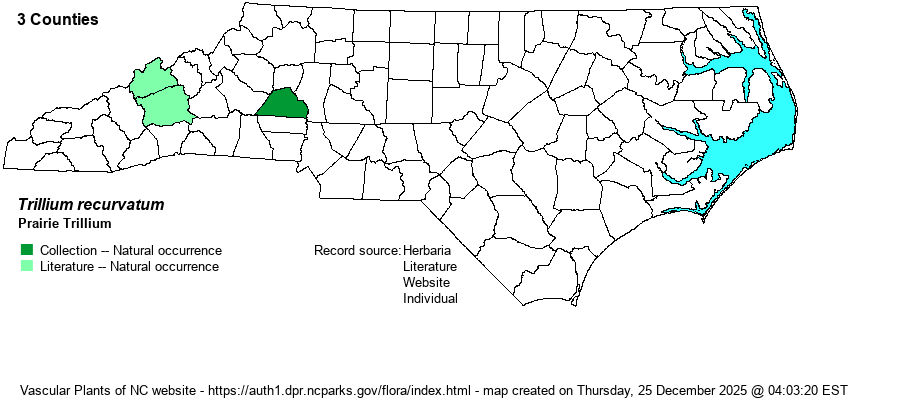| Author | Beck | |
| Distribution | Known from only several sites in the state, one in the west-central Piedmont (Catawba County) and the others in the central Mountains. The NCNHP database indicates that the Catawba County site was first found around 2006; the Madison County record is not in the NCNHP database nor in the SERNEC database, but only in Weakley (2022), who says that both sites "appear to be native". Photos are on iNaturalist from Madison County and also from Buncombe County. Sadly, the Catawba County site was bulldozed in the past few years (fide W. Knapp).
This is essentially a Mississippi River species, with a distribution showing (on BONAP) its presence in nearly all counties in IL and IN south into AR. It extends north to southern MI and southern WI, and south to central parts of Gulf Coast states from AL to eastern TX. The two NC counties are a bit disjunct to the east, as it is not known from VA nor from nearly all of the Appalachian Mountains. For the time being, the NCNHP, Weakley (2022), and this website will consider it as a native species. | |
| Abundance | Extremely rare in the Mountains and western Piedmont. It is considered as State Threatened. | |
| Habitat | This is a species that requires high pH soils. In NC it is found (at the Catawba County site) in a floodplain forest that has other species characteristic of such circumneutral soil, such as Trillium rugelii. |
| Phenology | Blooms in April and early May, and fruits a month or two later. | |
| Identification | Though there are a number of other maroon/purple flowered trilliums in the state, this one is easily identified by its sepals, leaves, and petals. Its structure is fairly typical, being about 12 inches tall, with three mottled (with light green blotches) leaves that are ovate to widely elliptical and about 4 inches long. Unlike other trilliums, this one has stalked leaves, with distinct petioles about 1/3-inch long; others have sessile leaves. The sepals of this species are strongly recurved downward, to point toward the ground; other trilliums generally have spreading sepals. Also, the sessile flowers (essentially no stalk) have the maroon petals with a narrowed base (like a claw); other trilliums with maroon flowers have petals that gradually taper to the base. This is such an extremely rare species in NC that hardly anyone will be able to find or see it, so check out photos online or in references to help gain a search image for this distinctive species with odd leaf and petal bases and strongly downward-pointing sepals. Note -- this species can have yellow or greenish-yellow flowers (though rarely), as can a few other mostly maroon species such as T. cuneatum. However, the odd shapes of the parts listed above should still be eye-catching. | |
| Taxonomic Comments | None
| |
| Other Common Name(s) | Recurved Trillium, Prairie Wake-robin, Bloody Butcher | |
| State Rank | S1 | |
| Global Rank | G5 | |
| State Status | T | |
| US Status | | |
| USACE-agcp | FACU link |
| USACE-emp | UPL link |

